The following article has been published in the Metchosin Muse:
Witty’s Beach joins other KBAs in the Victoria area :
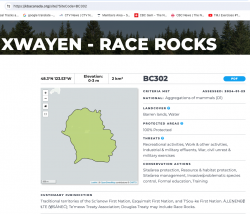 The other local KBA designation is at Race Rocks Ecological Reserve
The other local KBA designation is at Race Rocks Ecological Reserve

The following article has been published in the Metchosin Muse:
Witty’s Beach joins other KBAs in the Victoria area :
 The other local KBA designation is at Race Rocks Ecological Reserve
The other local KBA designation is at Race Rocks Ecological Reserve
The determination of the natural boundary of the coastline is important in establishing ownership of property and therefore public access along a coastline: The following reference may help clarify this .
 Triglochin maritima grows in the marsh of Gooch Creek
Triglochin maritima grows in the marsh of Gooch Creek
Each year I harvest last years stems of Phragmites in my estuary/marsh for mason bee tubes. It is important that this is done in the early spring only before new shoots start to emerge. I have a theory that this native Phragmites exists in this particular marsh only because the marsh was fenced in the early years to prevent grazing by cattle and sheep. It has been eliminated from most of the other marshes in BC by grazing (personal communication with Robert Prescott-Allen). The reason this marsh was fenced probably was that the plant Triglochin maritima (Sea arrow grass) grows in the marsh and it is toxic to grazers. ( see below)
Scientific classification
Kingdom: Plantae
(unranked): Angiosperms
(unranked): Monocots
Order: Alismatales
Family: Juncaginaceae
Genus: Triglochin
Species: T. maritima
Binomial name
Triglochin maritima L.
The following is a quote from the Canadian Biodiversity Information facility:
Seaside arrow-grass (Triglochin maritima) is a native plant found sporadically across Canada in saline, brackish, or fresh marshes and shores. This plant contains cyanogenic glycosides, which can release HCN during mastication by animals. Poisoning occurs primarily with ruminants, including cattle and sheep. The concentration of toxic chemicals increases during times of moisture depletion (Majak et al. 1980, Cooper and Johnson 1984, Poulton 1989).
Go to ITIS*ca for more taxonomic information on: Triglochin maritima
Cyanide poisoning from seaside arrow-grass is similar to symptoms discussed under sheep.
Cyanide poisoning of sheep by seaside arrow-grass includes the following symptoms: nervousness, trembling, erratic breathing, convulsions, recumbency, and death. Postmortem findings reveal bright red blood and the smell of bitter almonds in the stomach. Treatment, if started early enough, can be successful. Intravenous injections of an aqueous solution of sodium thiosulfate have proved to be effective (Cooper and Johnson 1984).
In Mid-April, native species provide a colourful display on Tower Point next to the ocean.
I was also impressed with the display of a high biodiversity of Bryophytes ( mosses) on the rocky shore just above the spray zone:
In this rocky exposed area on the East side of Tower Point was also located an interesting small tuft grass with rather large heads which I had not seen before:
In the Metchosin Bioblitz I came across a plant which I had not seen before called American Brooklime, Veronica beccabunga.
This plant grows as an edible herbaceous perennial in a 1 Meter square patch in amongst the grasses in the estuary lagoon . The area is only flooded with sea water in the winter at an extreme high tide with a strong east wind blowing. Close up, it has very striking flowers. The plant was in bloom on May 24, 2014.
| Kingdom: | Plantae |
| (unranked): | Angiosperms |
| (unranked): | Eudicots |
| (unranked): | Asterids |
| Order: | Lamiales |
| Family: | Plantaginaceae |
| Genus: | Veronica |
| Species: | V. americana |
By Garry Fletcher, Metchosin, British Columbia
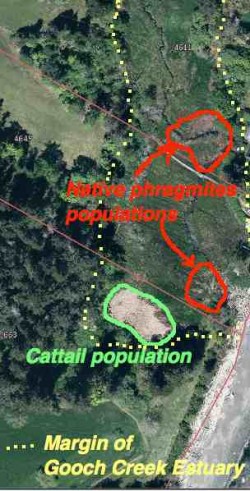
The yellow dots show the margin of the Gooch Creek Estuary. The populations of native Phragmites are shown in red. Location: 48deg,22′,11.01″N—123deg 31’52.19″ W.
Introduced species are no doubt one of the most serious challenges for us in the effort to preserve ecological integrity*. Occasionally however we can mete out a death sentence to an innocent which can have serious consequences. This post is about one such occurrence with the native marsh/estuary grass Phragmites australis (Cav.) Trin. ex Steud. subsp. americanus
When we first bought our property on William Head Road, I was intrigued with the variety of ecosystems that could fit into one small 4 hectare piece of land. One such ecosystem was the seasonally flooded salt marsh at the foot of the property. In that marsh were two populations of a very tall (2-3 metre) marsh reed grass.
In the mid-1980s, I asked one of our members of * MEASC, Robert Prescott-Allen to identify the species for me and he came up with the genus name Phragmites. He indicated that it used to be more common in our coastal estuaries, but it had been destroyed in the early years with cattle trampling and grazing. Now it only occurs in limited populations in BC and in some populations along the Oregon Coast.
When I made the website MetchosinCoastal , I included a profile on the marsh with images of this plant on the Taylor Beach/Gooch Creek page . 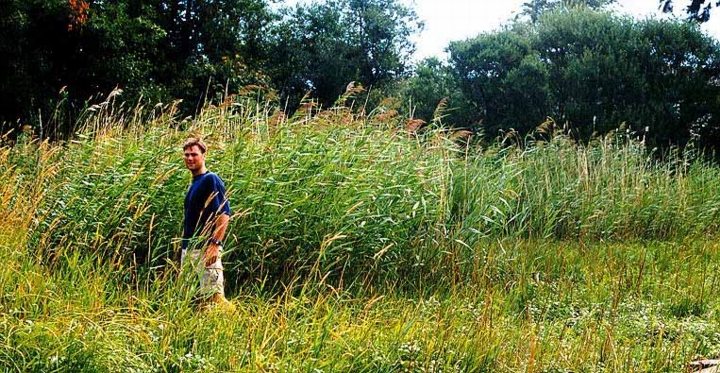 Fast forward twenty years or so until 2009. I received a call from the Invasive Plant EDRR Coordinator | B.C. Ministry of Forests, Lands & Natural Resource Operations
Fast forward twenty years or so until 2009. I received a call from the Invasive Plant EDRR Coordinator | B.C. Ministry of Forests, Lands & Natural Resource Operations
PO Box 9513, 8-727 Fisgard St, Victoria B.C. CANADA V8W 9C1. She indicated that there were 9 populations of the introduced species Phragmites australis (Cav.) Trin. in BC and it was their mandate to control all of them. She came out to the farm, took samples and pictures and I sent her pictures of the extent of the grass in the marsh over the last few years indicating it really hadn’t spread that much. She made reference to a sample in the RBC museum which had been collected from our pond in 1992 which was identified as the introduced variety.
She indicated she would be out with a crew in the fall to cut the plants to the ground and spray with the herbicide Glyphosate . (and this being next to a sea-run cutthroat stream!)
On their website, the locations of this plant in BC were identified . When the call came that they were coming out, I started to do research on the species. I valued this plant as a great nesting habitat for red-winged blackbirds, and in the summer they get infested with aphids, providing food to wasps, marsh wrens and other birds. In addition, the hollow stems made excellent homes for Mason Bees.
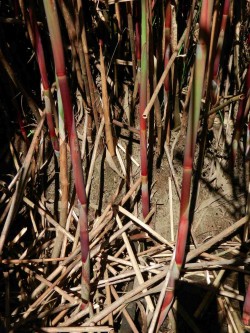
The red stems mentioned on the Oregon ID website are visible in the growing season on our population of reeds. I checked in early Dec.2013 and the red color is still visible.
I referred to a website from the Government of Oregon, which gave a comparison on the physical features of native , (Phragmites australis subsp.americanus) and introduced species samples. It looked very much like the native species to me, with most of the morphological characteristics corresponding. It also indicated that DNA analysis of tissue samples was the only definitive way to determine the genotype of the species.
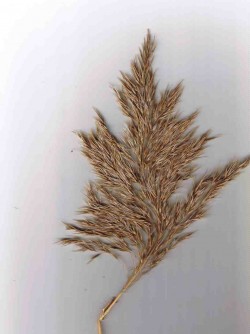
This species reproduces both asexually by underground root-stalks as well as sexually by seeds born on panicles such as this.
water with heavy winter rains, but only gets flooded with a salt water intrusion at high tides driven by a east-wind driven storm surge. (winter only)
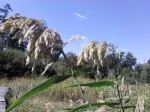 I tend to think that the salt water controls its distribution somewhat in this particular marsh. Interestingly, in recent years cattails have spread in the pond and they were previously also controlled by salt water. The main invasive in the marsh is reed canary grass.
I tend to think that the salt water controls its distribution somewhat in this particular marsh. Interestingly, in recent years cattails have spread in the pond and they were previously also controlled by salt water. The main invasive in the marsh is reed canary grass.
In December of 2013, I was contacted by a wetlands restoration company from Nanaimo, BC about the population, as they found out from the RBC museum that our population was the native variety. I had not heard this yet so I contacted Dr. Ken Marr at the museum, and he indicated that DNA tests had been done and that it was indeed the native species.
REFERENCES:
Kingdom Plantae – plantes, Planta, Vegetal, plants
Subkingdom Viridaeplantae – green plants
Infrakingdom Streptophyta – land plants
Division Tracheophyta – vascular plants, tracheophytes
Subdivision Spermatophytina – spermatophytes, seed plants, phanérogames
Infradivision Angiospermae – flowering plants, angiosperms, plantas com flor, angiosperma, plantes à fleurs, angiospermes, plantes à fruits
Class Magnoliopsida
Superorder Lilianae – monocots, monocotyledons, monocotylédones
Order Poales
Family Poaceae – grasses, graminées
Genus Phragmites Adans. – reed
Ed. Note: Species subspecies americanus is the native species
in North America. Phragmites australis (Cav.) Trin. ex Steud. – common reed
-introduced species in North America
See posts on the use of Phragmites stems for culturing Mason Bees here:http://www.gfletcher.ca/?tag=phragmites
Values and Views
Island Trust Communities
Marine By Nature
The Islands within the Salish Sea have been shaped by ancient glaciers and modern oceanic forces. Whether you visit the islands seasonally or live here year round, Islanders treasure the marine environment. The North Pender Local Trust Committee has developed this brochure to introduce you to where sensitive marine habitats exist, how you can recognize them, and what simple steps you can take to ensure our local waters continue to support a vibrant and abundant marine ecosystem.
This PDF has been produced by the North Pender Island Local Trust Committee: Sharing Our shorelines_lowres
Clean Water
Shoreline erosion
Coastal Bluffs and Shoreline beaches
Marine Riparian Vegetation
Intertidal Habitats
Beach-spawning Forage Fish
Eelgrass habitats
Kelp Forests and Rocky Reefs
Marine shorelines as critical fish habitats
In the past few years, Dr. Tom Reimchen of the University of Victoria and his students have established clear relationships between the health of Coastal forest ecosystems and the ocean through the food webs involving salmon. Below are links from the publications of Dr. Tom Reimchen to some of the research articles and papers they have published on this topic:
49. Reimchen, T. E. 2000a. Some ecological and evolutionary aspects of bear – salmon interactions in coastal British Columbia. Can. J. Zool. 78: 448-457. (.pdf version)
60. Hocking, M. D. & T. E. Reimchen. 2002. Salmon-derived nitrogen in terrestrial invertebrates from coniferous forests of the Pacific Northwest. BioMedCentral Ecology 2:4-14. ( http://www.biomedcentral.com/1472-6785/2/4/qc ) (.pdf version)
63. Reimchen, T. E. D. Mathewson, M. D. Hocking, J. Moran and D. Harris. 2003. Isotopic evidence for enrichment of salmon-derived nutrients in vegetation, soil and insects in riparian zones in coastal British Columbia. American Fisheries Society Symposium 34: 59-69. (.pdf version)
66. Mathewson, D., M.H. Hocking, and T. E. Reimchen . 2003. Nitrogen uptake in riparian plant communities across a sharp ecological boundary of salmon density. BioMedCentral Ecology 2003:4. (.pdf version)
70. Wilkinson, C. E., M. H. Hocking, T. E. Reimchen. 2005. Uptake of salmon-derived nitrogen by mosses and liverworts in Coastal British Columbia. Oikos 108: 85-98. (.pdf version)
76. Hocking, M.D and Reimchen T.E. 2006. Consumption and distribution of salmon (Oncorhynchus spp.) nutrients and energy by terrestrial flies Can. J. of Fish. and Aquatic Sciences 63: 2076-2086. (.pdf version)
87. Christie, K. S., M.D. Hocking, and T.E. Reimchen. 2008. Tracing salmon-derived nutrients in riparian foodwebs: isotopic evidence in a ground-foraging passerine. Can. J. Zool. 86: 1317-1323. (.pdf version).
98. Hocking, M.D., R. A. Ring and T. E. Reimchen. 2009. The ecology of terrestrial invertebrates on Pacific salmon carcasses. Ecol. Res. (.pdf version)
102. Darimont. C.T., Bryan, H., Carlson, S.M., Hocking, M.D., MacDuffee, M., Paquet, P.C., Price, M.H.H., Reimchen, T. E., Reynolds, J.D., & Wilmers, C.C. 2010. Salmon for terrestrial protected areas. Conservation Letters 3: 379-389. (.pdf version)
TR12. Reimchen, T. E. 2001. Salmon nutrients, nitrogen isotopes and coastal forests. Ecoforestry 16:13-17. (.pdf version)
TR15. Reimchen, T. E. 2004. Marine and terrestrial ecosystem linkages: the major role of salmon and bears to riparian communities. Botanical Electronic News. BEN#328. http://www.ou.edu/cas/botany-micro/ben/ben328.html